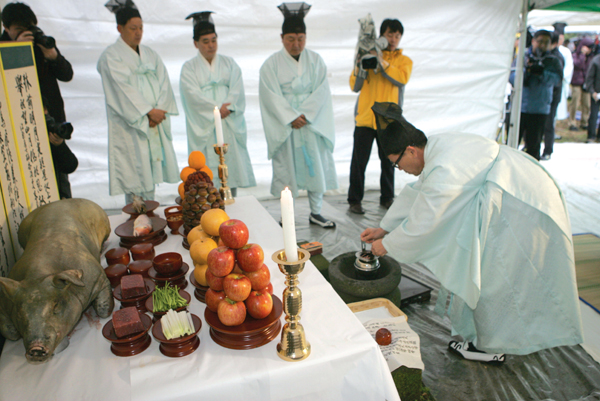
- Updated 2024.4.24 17:16
- All Articles
-
member
icon
-
facebook
cursor
-
twitter
cursor
| |
 |
|
| ▲ The Halla Sanshinjae ritual, which asks the blessing of the mountain god, is designated a national sacrificial rite. Photo courtesy Jeju City Hall |
A Shamanistic rite called Halla Sanshinjae is a Jeju tradition that is hundreds of year old. In the ritual, offerings are made to the god of Mount Halla to ask for safety and blessings throughout the year. This year, it was held on March 8 at Sancheondan, Ara-dong, near Jeju National University, and attended by key government officials including Kim Tae Hwan, the governor of Jeju Special Self-Governing Province.
During the rite, Kim read, “please bless us all and let everyone’s wish come true this year. Please keep us safe from three disasters - fire, flood and typhoon - and prevent eight sufferings - hunger, thirst, cold, heat, water, fire, murder and war.”
The annual rite dates back to the ancient Tamna Kingdom and was originally held in February at Baeknokdam, the crater lake at the top of Mount Halla. However, harsh winds and fierce cold at that time caused injuries and even claimed the lives of some participants who were carrying offerings. Thus, the rite was moved to Sancheondan, which is much warmer, and a month later, in 1470. Since about 300 years later, in 1703, the rite has been performed on a larger scale for the welfare of the entire country with official designation as a national sacrificial rite.
From 1908 during the Japanese colonial period, the rite was banned as part of Japan’s policy to obliterate Korean culture. The ritual was revived somewhat after Korea gained independence from Japan as many Jeju residents began to recognize its value and it was designated as Jeju’s No. 1 Tangible Cultural Asset in 2002.
Sancheondan, the site for the ritual, is also a famous tourist attraction which boasts eight pine trees that, at between an estimated 500 and 600 years old, are the oldest in Korea. Many of the trees on the mainland were chopped down for use by the Japanese during the colonial period.
|
|
|
|
|
|
|
|
ⓒ Jeju Weekly 2009 (http://www.jejuweekly.net)
All materials on this site are protected under the Korean Copyright Law and may not be reproduced, distributed, transmitted, displayed, published without the prior consent of Jeju Weekly. |
|
|
|
|
| Jeju-Asia's No.1 for Cruise |
|
|
|
Title:The jeju Weekly(제주위클리) | Mail to editor@jejuweekly.net | Phone: +82-64-724-7776 Fax: +82-64-724-7796
#503, 36-1, Seogwang-ro, Jeju-si, Jeju-do, Korea, 63148
Registration Number: Jeju, Ah01158(제주,아01158) | Date of Registration: November 10,2022 | Publisher&Editor : Hee Tak Ko | Youth policy: Hee Tak Ko
Copyright ⓒ 2009 All materials on this site are protected under the Korean Copyright Law and may not be reproduced, distributed, transmitted, displayed, published
without the prior consent of jeju weekly.com.

|




















